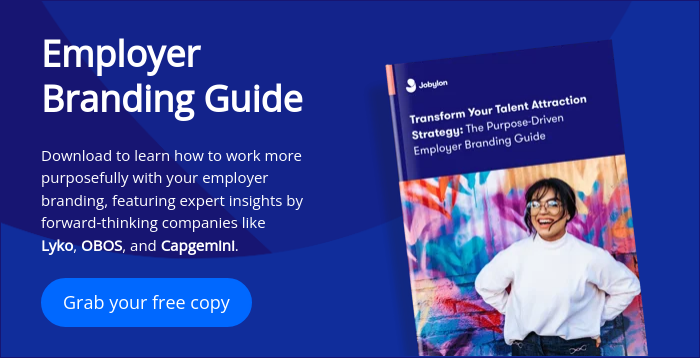With recessions predicted to affect at least a third of the world's population, 2023 looks set to be another challenging year for the staffing industry. When the economy declines, so does the demand for workers. As others tighten their belts and job insecurity looms, shouldn’t your recruitment efforts be curtailed?
 While it is true that a time of crisis typically equates to a hiring slowdown, there is a silver lining to a recession. Because fewer businesses are actively looking for talent, your competition is significantly reduced. Moreover, many people currently holding down jobs may find themselves financially vulnerable and open to new possibilities. This gives you a chance to cast a wider net in search of your ideal candidate pool.
While it is true that a time of crisis typically equates to a hiring slowdown, there is a silver lining to a recession. Because fewer businesses are actively looking for talent, your competition is significantly reduced. Moreover, many people currently holding down jobs may find themselves financially vulnerable and open to new possibilities. This gives you a chance to cast a wider net in search of your ideal candidate pool.
But how can recruiters maximize this opportunity while navigating a recession? In this article, we will share six tactics that will help you get ahead in turbulent times.
1. Optimize your recruitment processes
When recruitment is moving at top speed, there is not much time to examine data to determine what is effective and what is not. But as recruitment slows down, you have the chance to take a step back and analyze how your processes are working. Take a look at how candidates move through the pipeline and identify any bottlenecks that may be impeding progress. Here are some questions to ask yourself when evaluating your recruitment practices.
- How quickly are candidates moving through the pipeline?
- Where in the process are you losing candidates?
- Are your recruitment criteria effective in attracting the right candidates?
- Are the applications you are receiving of high quality?
- Is your onboarding process delivering a positive experience for your new hires?
As you examine critical parts of your recruitment process, consider making adjustments where needed. These tweaks could be as simple as updating job descriptions or as complex as overhauling your entire applicant tracking system. Regardless of the size of the changes you make, taking steps to optimize your hiring process during a recession can go a long way in putting you in a strong position for success when things begin to turn around.
2. Upskill employees to better meet market demand
Hiring a new employee is an expensive and time-consuming process. Many companies estimate that the total cost of recruiting new staff can be three to four times the position’s salary and may take an average of 36 days to fill. This means if you are recruiting for a role that pays $50,000, your organization will likely spend $150,000 or even more to find the right person for the job. In a challenging economic climate, this is a big investment to make when you may already be struggling to balance expenses and maintain profitability.
On the other hand, it is less expensive to train an existing employee than it is to hire a new one. So, rather than spending money on external hires or expensive recruitment tools, look for ways to upskill your current employees to meet market demand. This can be done by expanding their roles to include new responsibilities or by retraining them for new skills. Taking the time to invest in your employees will not only give them the opportunity to grow and learn, but it can also boost morale and engagement within the organization.
3. Build your talent pipeline
While a recession often causes a reduction of open positions, it can also lead to an increase in qualified applicants looking for work. This provides you with an opportunity to tap into a larger talent pool that may not have been available during better economic times. One of the best ways to take advantage of this influx of candidates is to build a robust talent pipeline. By maintaining a pool of active and engaged candidates, you will be ready to respond when the market rebounds and new opportunities arise. A strong talent pipeline acts as insurance for your upcoming hiring plans - you won’t need to use it very often, but it’s there when you need it. Some of the key components to consider when building a pipeline include:
- Define the gaps you are looking to fill within your workforce to ensure that you have a full understanding of your recruitment needs
- Create your ideal candidate persona to help you target the right types of candidates
- Use channels where your ideal candidates spend their time, such as social media, portfolio sites, and industry events
- Tailor your outreach to capture the attention of your ideal candidates and encourage applications
- Measure success so that you can continually improve your approach
4. Hire temporary workers
During challenging economic times, hiring permanent staff can be a significant financial undertaking that may place undue strain on your budget. This can be particularly difficult if your organization has an urgent need for specific skill sets that cannot be fulfilled with internal resources. In these cases, hiring temporary workers, such as part-time or contract workers and freelancers, can play an important role as an interim solution during lean times.
Temporary workers give you the flexibility to fill staffing gaps as they arise without having to make the commitment of regular employment. Not only can a temporary worker provide the additional staffing you need, but they can also come at a much lower cost than permanent employees. For example, a temporary worker does not typically receive the same benefits package as a permanent employee, nor do they accrue vacation over the course of their employment. This may result in a lower overall cost for your business, which can potentially free up resources for other areas during your time of need.
When hiring temporary workers, it is important to exercise the same due diligence that you would when recruiting permanent employees. You want to ensure that they will be able to perform the job duties effectively and be a good fit within the organization. Just like any hiring decision, you must take the time to conduct a thorough interview process and evaluate your candidates based on relevant criteria. And just like any employee you hire, it is essential to communicate your expectations clearly and ensure they have the resources and training they need to succeed in the role.
5. Switch to remote work
If you haven’t already adopted a remote working model for your workforce, now may be a good time to start exploring this option. Remote working has become increasingly popular among employers in recent years, and for a good reason. Having a remote workforce allows businesses to reduce costs and boost productivity while offering their employees more flexibility and better work-life balance. It is estimated that businesses can save an average of more than $10,000 per employee per year by switching to a remote working model. This cost has the potential to have a significant impact on your bottom line during a period of slow growth or a recession.
If your organization has employees who require regular face-to-face interaction with their colleagues, you might want to consider using a hybrid model that incorporates some elements of both remote and on-site work. Implementing a blended approach will enable you to cut 50% of real estate costs without negatively impacting your productivity levels. However, before shifting to a remote or hybrid model, it is important to ensure that you provide your employees with the right tools and technologies to help them be productive and efficient in a remote environment. These may include high-quality video conferencing tools, effective collaboration platforms, and remote project management solutions.
6. Nurture your employer brand
In a recession, many companies tend to shift their focus away from their employer brand and focus more on cutting costs and improving revenue. While it is important to generate revenue and maintain profitability, it is equally important to build relationships with your current and future employees and encourage them to stay with your company even during periods of economic hardship. LinkedIn’s research indicated a strong correlation between a company’s ranking in the employer branding index and its ability to attract and retain top talent. They found that companies with a strong employer brand showed a 28% lower turnover rate, more than 50% reduction on cost per hire, and higher consideration from candidates when evaluating job offers.
Revisit your branding strategy and identify ways in which you can strengthen your employer value proposition. Make sure it aligns with the needs and interests of your target audience. An employer brand is not what you say about yourself but what others say about you. So, make use of your career site and social media to promote your brand and encourage your employees to share positive stories about working at your company. Conduct surveys and focus groups to find out what makes your employees happiest about working at your company and build on these strengths by emphasizing them in your messaging.
Conclusion
A recession is not an easy time for recruitment as many businesses are forced to cut back or freeze hiring activities. However, savvy recruiters can capitalize on this challenging period by shifting their focus and re-evaluating their recruitment strategies to attract and retain the best talent in a cost-effective manner. Following the tips outlined in this article, you will be able to effectively counter the challenges of an economic downturn and emerge stronger and more equipped to deal with uncertainties that lie ahead.





